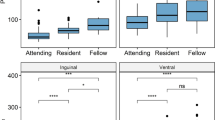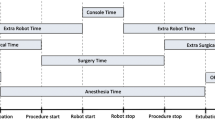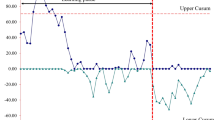Abstract
Introduction
Robotic extended totally extraperitoneal hernia (eTEP) repair is a novel technique for minimally invasive ventral hernia repair with retromuscular placement of mesh. This study aimed to evaluate the learning curve for robotic eTEP hernia repair using risk-adjusted cumulative sum (RA-CUSUM) analysis for two general surgeons—one with dedicated fellowship training in robotic eTEP technique (surgeon 2) and another without robotic eTEP-specific training (surgeon 1).
Methods
We conducted a retrospective analysis of 98 patients undergoing robotic eTEP hernia repair from July 2020 to February 2022 for two surgeons. RA-CUSUM method was applied to the overall operative time (OT) in minutes, adjusting for transversus abdominis release (TAR).
Results
Figures 3 (surgeon 1) and 4 (surgeon 2) illustrate the three phases in the RA-CUSUM graphs of OT. For surgeon 1, the cases for each phase were determined: phase 1 (1 to 12), phase 2 (13 to 24), and phase 3 (25 to 51). For surgeon 2, the three phases were similarly determined as 1 to 8, 9 to 32, and 33 to 47, respectively. A significant (p = 0.017) difference existed for the OTs between phases 1 (262 ± 69) and 3 (192 ± 63.0) for surgeon 1. OT compared to the risk-adjusted value stabilized after case 12 and decreased after case 24 for surgeon 1; it began to decrease after case 8 for surgeon 2.
Conclusions
The initial learning curve for surgeon 1 reached its plateau after 12 cases, shorter than comparable studies. This was likely due to the surgeon’s intentional focus on learning this technique through courses, proctoring, and active mentorship. The flat learning curve seen in surgeon 2’s series illustrates the value of experience gained during fellowship training. Our data support that, given the right resources and support, a short learning curve for eTEP is attainable for community surgeons without prior training in the technique.





Similar content being viewed by others
References
Daes J (2012) The enhanced view-totally extraperitoneal technique for repair of inguinal hernia. Surg Endosc 26(4):1187–1189. https://doi.org/10.1007/s00464-011-1993-6
Belyansky I, Reza Zahiri H, Sanford Z, Weltz AS, Park A (2018) Early operative outcomes of endoscopic (eTEP access) robotic-assisted retromuscular abdominal wall hernia repair. Hernia 22(5):837–847. https://doi.org/10.1007/s10029-018-1795-z
Martin-del-Campo LA, Weltz AS, Belyansky I, Novitsky YW (2018) Comparative analysis of perioperative outcomes of robotic versus open transversus abdominis release. Surg Endosc 32(2):840–845. https://doi.org/10.1007/s00464-017-5752-1
Berguer R, Smith W (2006) An ergonomic comparison of robotic and laparoscopic technique: the influence of surgeon experience and task complexity. J Surg Res 134(1):87–92. https://doi.org/10.1016/j.jss.2005.10.003
Van Der Schatte Olivier RH, Van’t Hullenaar CDP, Ruurda JP, Broeders IAMJ (2009) Ergonomics, user comfort, and performance in standard and robot-assisted laparoscopic surgery. Surg Endosc 23(6):1365–1371. https://doi.org/10.1007/s00464-008-0184-6
Rodrigues V, López-Cano M (2021) TARUP technique. Advantages of minimally invasive robot-assisted abdominal Wall surgery. Cir Esp 99(4):302–305. https://doi.org/10.1016/j.ciresp.2020.10.008
Mitura K, Romańczuk M, Kisielewski K, Mitura B (2023) eTEP-RS for incisional hernias in a non-robotic center. Is laparoscopy enough to perform a durable MIS repair of the abdominal wall defect? Surg Endosc 37:1392–1400. https://doi.org/10.1007/s00464-022-09365-w
Park JS et al (2019) Cumulative sum analysis of learning curve for video-assisted mini-laparotomy partial nephrectomy in renal cell carcinoma. Medicine (United States) 98(17):e15367. https://doi.org/10.1097/MD.0000000000015367
Lima DL, Berk R, Cavazzola LT, Malcher F (2023) Learning curve of robotic enhanced-view extraperitoneal approach for ventral hernia repairs. J Laparoendosc Adv Surg Tech A 33(1):81–86. https://doi.org/10.1089/lap.2022.0270
Morrell ALG, Morrell A, Morrell-Junior AC, de Freitas Mendes JM, Morrell AG (2020) Standardization and ten essential steps in the lateral robotic extended totally extraperitoneal (Etep) repair of ventral hernias. Rev Col Bras Cir 47:1–12. https://doi.org/10.1590/0100-6991E-20202622
Cesar D et al (2019) Cumulative sum analysis of the robotic learning curve in the surgical management of malignant pelvic neoplasms. Laparosc Surg 3:33–33. https://doi.org/10.21037/ls.2019.07.07
Mackenzie H et al (2013) Clinical and educational proficiency gain of supervised laparoscopic colorectal surgical trainees. Surg Endosc 27(8):2704–2711. https://doi.org/10.1007/s00464-013-2806-x
Woodall WH, Rakovich G, Steiner SH (2021) An overview and critique of the use of cumulative sum methods with surgical learning curve data. Stat Med 40(6):1400–1413. https://doi.org/10.1002/sim.8847
Bokhari MB, Patel CB, Ramos-Valadez DI, Ragupathi M, Haas EM (2011) Learning curve for robotic-assisted laparoscopic colorectal surgery. Surg Endosc 25(3):855–860. https://doi.org/10.1007/s00464-010-1281-x
Kudsi OY et al (2021) Learning curve of robotic Rives-Stoppa ventral hernia repair: a cumulative sum analysis. J Laparoendosc Adv Surg Tech 31(7):756–764. https://doi.org/10.1089/lap.2020.0624
Rhemtulla IA, Fischer JP (2018) Retromuscular sublay technique for ventral hernia repair. Semin Plast Surg 32(3):120–126. https://doi.org/10.1055/s-0038-1666800
Holihan JL, Nguyen DH, Nguyen MT, Mo J, Kao LS, Liang MK (2016) Mesh location in open ventral hernia repair: a systematic review and network meta-analysis. World J Surg 40(1):89–99. https://doi.org/10.1007/s00268-015-3252-9
Acknowledgements
The authors would like to thank Emily Mazure for her tremendous assistance in literature review for this manuscript.
Disclaimer
This research was supported (in whole or in part) by HCA Healthcare and/or an HCA Healthcare affiliated entity. The views expressed in this publication represent those of the author(s) and do not necessarily represent the official views of HCA Healthcare or any of its affiliated entities.
Funding
No funding has been received for this study.
Author information
Authors and Affiliations
Corresponding author
Ethics declarations
Disclosures
Dr. McPhail is a proctor for Intuitive Surgical and Dr. O’Connor is a consultant for Intuitive Surgical and W.L. Gore. These involvements by Dr. McPhail and Dr. O’Connor are outside this submitted work. Drs. Korneffel and Belden, as well as Ms. Nuzzo, have no conflicts of interest or financial ties to disclose.
Additional information
Publisher's Note
Springer Nature remains neutral with regard to jurisdictional claims in published maps and institutional affiliations.
Rights and permissions
Springer Nature or its licensor (e.g. a society or other partner) holds exclusive rights to this article under a publishing agreement with the author(s) or other rightsholder(s); author self-archiving of the accepted manuscript version of this article is solely governed by the terms of such publishing agreement and applicable law.
About this article
Cite this article
Korneffel, K., Nuzzo, W., Belden, C.M. et al. Learning curves of robotic extended totally extraperitoneal (eTEP) hernia repair among two surgeons at a high-volume community hospital: a cumulative sum analysis. Surg Endosc 37, 9351–9357 (2023). https://doi.org/10.1007/s00464-023-10349-7
Received:
Accepted:
Published:
Issue Date:
DOI: https://doi.org/10.1007/s00464-023-10349-7




